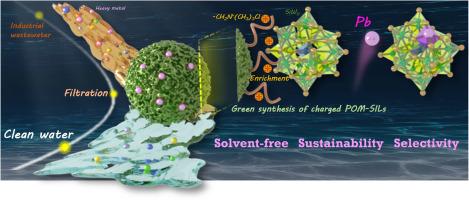氨驱动绿色合成带电多金属氧酸盐负载离子液体用于实际工业废水中特殊重金属的修复
IF 11.4
1区 环境科学与生态学
Q1 ENGINEERING, ENVIRONMENTAL
引用次数: 0
摘要
长期以来,将有毒金属浓度降至极低水平一直是一项挑战。多金属氧酸盐负载离子液体(POM-SILs)为高级水修复提供了巨大的潜力,但其应用受到复杂制备、有毒溶剂和浸出稳定性差的限制,影响了可持续性。我们介绍了一种可持续的方法,用于选择性去除复杂电镀废水中的Pb(II),使用带电的POM-SILs复合材料,通过直接接枝空位Keggin离子([α-SiW11O39]8−,SiW11)到带电的氨化聚苯乙烯上,通过简单,无溶剂的工艺合成。这些POM-SILs在交联聚合物基质中具有单分散的纳米团簇(< 5nm),确保了最佳的位点可达性和增强的稳定性,而浸出可以忽略不计。它们实现了卓越的Pb(II)选择性,其分布系数(Kd)为23,605 mL g−1,是传统离子交换树脂的120倍以上,即使在高盐度、多种重金属环境中,Pb(II)的去除效率也超过97.6%。它们的Q0.01值达到0.371 mg g - 1,每千克复合材料可有效处理多达2,200升废水,将铅(II)浓度降至0.01 mg L - 1以下,符合饮用水标准。该方法标志着重金属修复的实质性进展,为工业废水处理提供了一种高效、可持续的解决方案。本文章由计算机程序翻译,如有差异,请以英文原文为准。


Ammoniated-driven green synthesis of charged polyoxometalate supported ionic liquids for exceptional heavy metal remediation in actual industrial wastewater
Reducing toxic metal concentrations to extremely low levels has long posed a challenge. Polyoxometalate supported ionic liquids (POM-SILs) offer significant potential for advanced water remediation, but their application is limited by complex preparation, toxic solvents, and poor stability due to leaching, compromising sustainability. We introduced a sustainable approach for selectively removing Pb(II) in complex electroplating wastewater using charged POM-SILs composite, synthesized by directly grafting lacunary Keggin ions ([α-SiW11O39]8−, SiW11) onto charged ammoniated polystyrene via a straightforward, solvent-free process. These POM-SILs featured monodisperse nanoclusters (<5 nm) in a cross-linked polymer matrix, ensuring optimal site accessibility and enhanced stability with negligible leaching. They achieved exceptional Pb(II) selectivity, boasting a distribution coefficient (Kd) of 23,605 mL g−1-over 120 times greater than conventional ion-exchange resins-and a Pb(II) removal efficiency exceeding 97.6%, even in high-salinity, diverse heavy metal environments. They reached a large Q0.01 value of 0.371 mg g−1, effectively treating up to 2,200 liters of wastewater per kg composite, reducing Pb(II) concentrations to below 0.01 mg L−1, meeting drinking water standards. This method marks a substantial advancement in heavy metal remediation, offering an efficient and sustainable solution for industrial wastewater treatment.
求助全文
通过发布文献求助,成功后即可免费获取论文全文。
去求助
来源期刊

Water Research
环境科学-工程:环境
CiteScore
20.80
自引率
9.40%
发文量
1307
审稿时长
38 days
期刊介绍:
Water Research, along with its open access companion journal Water Research X, serves as a platform for publishing original research papers covering various aspects of the science and technology related to the anthropogenic water cycle, water quality, and its management worldwide. The audience targeted by the journal comprises biologists, chemical engineers, chemists, civil engineers, environmental engineers, limnologists, and microbiologists. The scope of the journal include:
•Treatment processes for water and wastewaters (municipal, agricultural, industrial, and on-site treatment), including resource recovery and residuals management;
•Urban hydrology including sewer systems, stormwater management, and green infrastructure;
•Drinking water treatment and distribution;
•Potable and non-potable water reuse;
•Sanitation, public health, and risk assessment;
•Anaerobic digestion, solid and hazardous waste management, including source characterization and the effects and control of leachates and gaseous emissions;
•Contaminants (chemical, microbial, anthropogenic particles such as nanoparticles or microplastics) and related water quality sensing, monitoring, fate, and assessment;
•Anthropogenic impacts on inland, tidal, coastal and urban waters, focusing on surface and ground waters, and point and non-point sources of pollution;
•Environmental restoration, linked to surface water, groundwater and groundwater remediation;
•Analysis of the interfaces between sediments and water, and between water and atmosphere, focusing specifically on anthropogenic impacts;
•Mathematical modelling, systems analysis, machine learning, and beneficial use of big data related to the anthropogenic water cycle;
•Socio-economic, policy, and regulations studies.
 求助内容:
求助内容: 应助结果提醒方式:
应助结果提醒方式:


